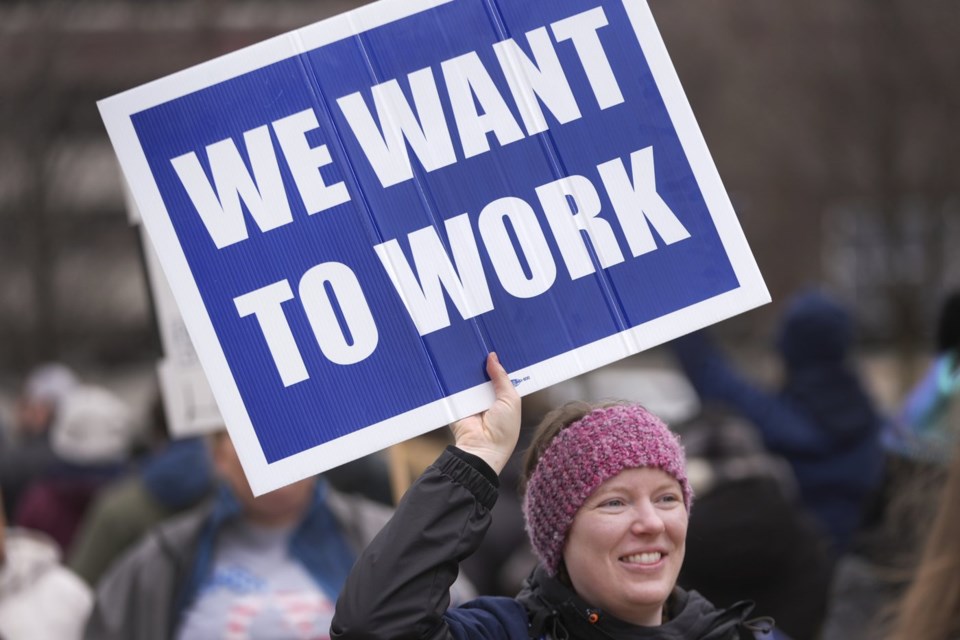WASHINGTON (AP) ā The U.S. labor market delivered another upside surprise last month, churning out a . The unemployment rate ticked down unexpectedly, too.
But the headline numbers masked some weaknesses as the U.S. economy contends with fallout from President Donald Trump's , especially his sweeping import taxes and the he rolls them out.
Here are five key takeaways from the jobs report the Labor Department released on Thursday.
The headline jobs numbers looked good
June hiring was up modestly from May's 144,000 increase in payrolls and beat the 118,000 jobs economists had forecast for last month. The unemployment rate slipped to 4.1% from 4.2% in May as the ranks of the unemployed fell by 222,000. Forecasters had expected the jobless rate to inch up to 4.3%.
Labor Department revisions added 16,000 jobs to April and May payrolls.
Average hourly wages came in cooler than forecasters expected, rising 0.2% from May and 3.7% from a year earlier. The year-over-year number is inching closer to the 3.5% considered consistent with the Federal Reserveās 2% inflation target.
Healthcare jobs increased by 39,000. State governments added 47,000 workers and local governments 33,000.
A closer look reveals weakening in the job market
āOn net, it was a good report,āā said Sarah House, senior economist with Wells Fargo, āBut when you dig underneath the surface, it was another jobs report that didnāt look quite as good as first meets the eye.āā
Private companies, for instance, hired just 74,000 workers last month, about half the 137,000 they hired in May. And it was the fewest hires since last October, when there were significant .
State and local governments added nearly 64,000 education jobs last month ā a total that may have been inflated by seasonal quirks around the end of the school year.
The U.S. labor force ā the count of those working and looking for work ā fell by 130,000 last month on top of a 625,000 drop in May.
Economists expect Trumpās ā and the fear of them ā to push foreign workers out of the labor force. A falling labor force can keep the unemployment rate lower than it would be otherwise. That is because jobseekers need time to find employment and can show up as unemployed in the interim.
A good job can be hard to find
With unemployment low, most Americans enjoy job security. But as hiring has cooled over the past couple of years itās become harder for young people or those re-entering the workforce to find jobs, leading to longer job searches or longer spells of unemployment.
The Labor Department said the number of discouraged workers, who believe no jobs are available for them, rose by 256,000 last month to 637,000.
When he was laid off earlier this year from his job as a communications manager for a city government in the Seattle area, Derek Wing braced for the worst. āThe word I would use is: āterrifyingāāā to describe the experience, he said. Lots of big local employers like Microsoft . And heād heard horror stories of people applying for jobs and then ā crickets. āI had a couple of experiences where I would apply for a job and just feel like it was going out into the ether and never hearing back,āā he said.
But Wingās fortunes turned quickly. He applied for an opening with Gesa Credit Union. Six weeks later ā āsuperfast in this economyāā -- he had a job as a communications strategist for Gesa.
The Fed is likely to stay put
The upside surprise in June payrolls likely will encourage the Fed to of leaving rates unchanged until it has a better idea of how Trumpās tariffs and other policies will affect inflation and the job market.
The Fed raised its benchmark interest rate 11 times in 2022 and 2023 to combat an outburst of inflation. As price pressures eased last year, the Fed reversed course and cut rates three times in 2024. More cuts were expected.
But the central bank has turned cautious this year. āTodayās results are more than positive enough to reduce expectations for Fed rate cuts in the wake of tariffs and policy chaos, at least for now,ā³ Carl Weinberg, chief economist at High Frequency Economics, wrote in a commentary.
After the jobs data was released Thursday, yields on U.S. Treasurys spiked immediately.
Traders in the futures market now see less than a 7% chance that the Fed could cut its main interest rate at its next meeting later this month. Thatās down sharply from the nearly 24% chance they saw just a day earlier, according to data from CME Group.
The outlook is cloudy
Employers are now contending with , especially his aggressive use of import taxes ā tariffs.
Mainstream economists say that tariffs raise prices for businesses and consumers alike and make the economy less efficient by reducing competition. They also invite retaliatory tariffs from other countries, hurting U.S. exporters.
Trump has increased the anxiety by imposing tariffs in an unpredictable way ā announcing and then suspending them, then coming up with new ones. The uncertainty has left businesses bewildered and hesitant to make decisions about hiring and investment.
House at Wells Fargo expects monthly job growth to fall below 100,000 in the second half of the year. āWeāre bracing for a much lower pace of job growth,ā³ she said. āThereās still a lot of policy uncertainty.ā³
Paul Wiseman, The Associated Press



